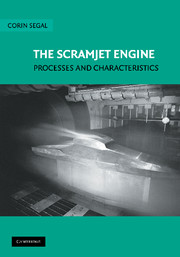Book contents
- Frontmatter
- Contents
- Preface
- List of Acronyms
- 1 Introduction
- 2 Theoretical Background
- 3 High-Temperature Gas Dynamics and Hypersonic Effects
- 4 Cycle Analyses and Energy Management
- 5 Inlets and Nozzles
- 6 Supersonic Combustion Processes
- 7 Testing Methods and Wind Tunnels
- 8 Computational Fluid Dynamic Methods and Solutions for High-Speed Reacting Flows
- Index
- References
8 - Computational Fluid Dynamic Methods and Solutions for High-Speed Reacting Flows
Published online by Cambridge University Press: 19 January 2010
- Frontmatter
- Contents
- Preface
- List of Acronyms
- 1 Introduction
- 2 Theoretical Background
- 3 High-Temperature Gas Dynamics and Hypersonic Effects
- 4 Cycle Analyses and Energy Management
- 5 Inlets and Nozzles
- 6 Supersonic Combustion Processes
- 7 Testing Methods and Wind Tunnels
- 8 Computational Fluid Dynamic Methods and Solutions for High-Speed Reacting Flows
- Index
- References
Summary
Introduction
Possibly few propulsion systems can benefit more from the development and application of predictive tools than the scramjet engine does, and possibly few flows can be more challenging to model and simulate. It is encouraging therefore that, among the technology topics that are important for the scramjet engine development, the predictive capabilities of computational fluid dynamics have made some of the greatest advances over the past decade. Flow-field simulation, heat transfer, fluid–wall interaction treatment, incorporation of detailed chemical kinetics models, more efficient models and numerical schemes, computations, and algorithms have all evolved considerably and took advantage of the ever-increasing hardware capacity and speed.
The scramjet flow field presents the predictive tools with a particularly difficult environment. High-Reynolds-number flow regimes dominate this flow field with embedded regions of low speed in recirculation regions. Regions of large thermal and composition gradients are present along with complex shock-wave structures. Complex chemical reactions take place with large differences in time scales and species production. Heat release and flow interactions contribute to further increase the complexity of the simulation. Occasionally, additional flow features are present. Multiphase flows, for example, which are present when liquid fuels are used or when particulates form during the combustion process, add their new issues involving phase change, relative phase velocity, radiative transport, etc.
A detailed, temporally accurate description of the scramjet flow field is still a daunting task despite the progress made by the computational capacity and massive parallelization of present computational tools.
Information
- Type
- Chapter
- Information
- The Scramjet EngineProcesses and Characteristics, pp. 229 - 250Publisher: Cambridge University PressPrint publication year: 2009
